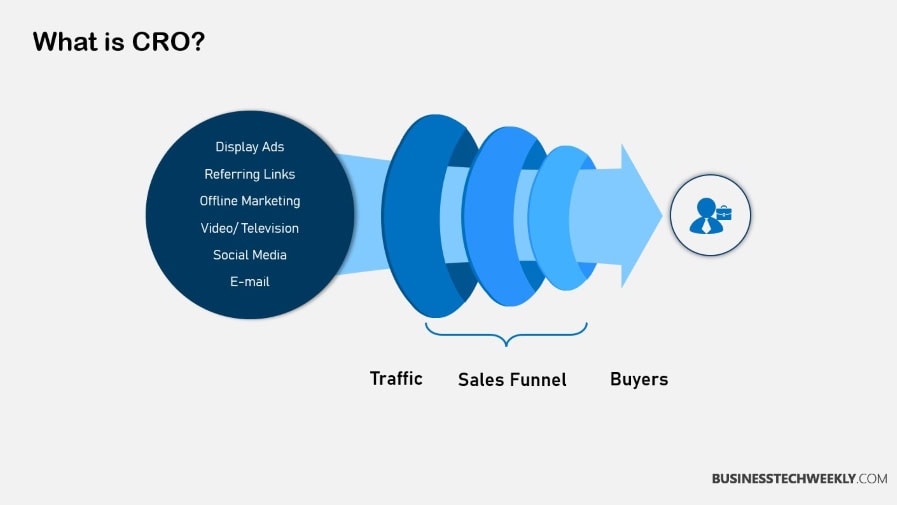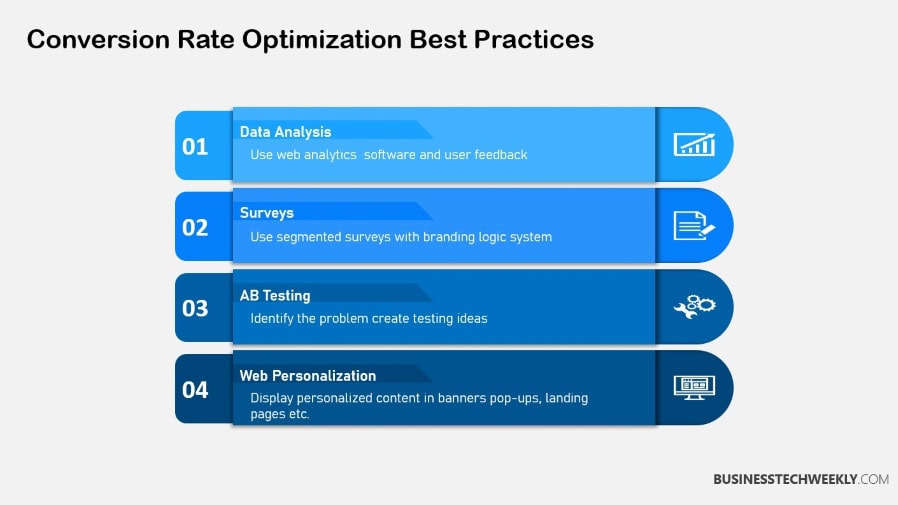Conversion Rate Optimization Strategies: Boosting your online conversions

On this page:
What is Conversion Rate Optimization
Conversion Rate Optimization (CRO) is the art and science of making your website visitors into customers and ultimately your brand advocates. You’ll start making targeted improvements to your site. This will increase the conversion percentage of your visitors who take the desired actions, such as buying a product or subscribing to a newsletter.
CRO is all about making the most out of the traffic you’ve already got. That’s because it ensures that each one of your visitors gets the best possible chance to convert.
Definition and Explanation
At its core, CRO is about making informed, strategic changes to your website in order to drive more conversions. This multifaceted process begins with data analysis, allowing you to pinpoint areas that need improvement.
Heat maps are a great way to see what users are clicking on the most. They show you where people are most drawn to on your site. Knowing what users are doing is key in this step. It provides the knowledge to create the strategies you’ll need to implement to affect real change.
Imagine it like perfecting a recipe—ongoing testing and tweaking is essential. A/B testing, for instance, enables you to test different versions of a page against each other to determine which one performs best.

Importance in Digital Marketing
CRO is an essential part of any digital marketing strategy making the most out of your ROI. For one thing, it’s all about getting the most out of the traffic you’re already getting, which is usually much cheaper than bringing in new visitors.
By optimizing your conversion rates, you aren’t just boosting short-term sales—you’re increasing your customer’s lifetime value. That’s because each customer is likely to spend more during their overall relationship with your business.
Additionally, a properly implemented CRO strategy improves user experience, ultimately making your site more user-friendly. Slow-loading websites, for example, can scare away prospective buyers—70% of consumers say that site speed influences their decision to buy.
By identifying and fixing these kinds of problems, you’ll help make sure every visitor has a frictionless trip from landing page to checkout. The insights you gain from CRO, like understanding which elements engage users most, can inform your broader marketing strategies.
Conversion rate optimization is not just a sidekick in your marketing strategy. That’s because even small improvements in conversion rates can lead to impressive revenue increases.
For instance, optimizing product reviews could result in a conversion improvement of 3% to 37%. It’s a cutthroat world out there for e-commerce and online entrepreneurs. With the average conversion rate sitting under 2.9%, every fraction of a percent counts.
CRO is a powerful tool for increasing short-term sales and it helps ensure the long-term sustainability of your business.
Key Strategies for Conversion Rate Optimization
1. Improve Website Usability
An intuitive website experience is critical for converting more visitors into paying customers. By making it easier for visitors to navigate your site and find exactly what they’re looking for, you’ll create a better overall experience.
An intuitive website design makes interaction straightforward, encouraging visitors to stay longer. Usability best practices suggest precise labeling, proper hierarchies of content, and intuitive flows and layouts.
Testing these elements with real users is the best way to pinpoint what needs improvement to better align with your user’s expectations and needs.
2. Optimize Landing Pages
Tailoring landing pages to specific audience segments increases engagement. Attention-grabbing headlines and convincing copy are the ultimate one-two punch.
Key factors for a landing page that converts need clear CTAs, eye-catching imagery, and a direct to-the-point messaging. Consistent monitoring of landing page performance is key to continuing to optimize and improve conversion rates.
An eBook offer is one of the best ways to capture leads. HotJar has a great example of this strategy with a great 3.05% conversion rate for new trial sign-ups.
3. Enhance Call-to-Action Buttons
Make sure CTAs are distinct in color or design to draw the eye and be specific in the desired action. Smart placement makes sure they stand out from the visitor’s eye.
Best practices for CTAs focus on urgency and relevance to the visitor’s journey. By testing a variety of designs and placements, one can come to find out what works best.
Even something like a strategically-timed pop-up that offers a discount code can make a huge difference to your conversions.
The average conversion rate for websites is approximately 2.35%. Top-performing websites achieve conversion rates of 11% or higher.
Invesp
4. Implement A/B Testing
A/B tests allow you to compare two or more versions of web pages or page elements. This optimization process uncovers a wealth of information about the factors that influence conversions.
The results of these tests will help determine what changes are the most effective and should be rolled out. Some elements to test are headlines, images, and layouts.
Continuously analyzing results will help you find new winning variations, paving the way for greater increases in conversion rates. A 360-degree view or demonstration video can offer a complete visual experience, enticing users to interact.
5. Leverage Social Proof
Having a dedicated section for customer reviews and testimonials further establishes a trustworthy image that can convince potential buyers. Social proof, like case studies and success stories, prove the weight of your offerings.
Ratings and user-generated content are just two examples of social proof. Promoting these will have a big impact on consumer decision-making, since trust is crucial to conversion.
6. Personalize User Experience
Creating highly targeted experiences that evolve with user interactions creates a more engaging, relevant experience. Using data to inform focused, personalized marketing campaigns keeps your messaging on point.
Smart techniques like dynamic content and list segmentation serve up exactly what each person wants to see. Measuring the impact of personalization is essential.
While personalization is a smart strategy, it’s especially potent because you can measure its impact on conversion rates.
7. Streamline Checkout Process
Removing friction from the checkout process through a simplified checkout process reduces cart abandonment and increases conversions. Providing a guest checkout option speeds up the purchase process, resulting in a better user experience.
Reassurance during the checkout process, such as progress indicators and the use of minimal form fields, is also important. By analyzing checkout metrics, you can pinpoint where users get stuck in the process.
Utilizing tools such as Shop Pay can drastically improve the checkout experience, streamlining the process to be fast and easy.

Common Metrics to Measure Effectiveness
In the realm of e-commerce and online selling, understanding and leveraging key metrics is crucial for optimizing conversion rates and driving growth. By focusing on effective conversion rate optimization techniques, you can enhance your strategies and keep your business ahead of competitors and regulators alike.
Conversion Rate
The conversion rate is the percentage of visitors that convert, or take a desired action. This might be as simple as making a purchase or more complex as signing up for a newsletter.
To find it, take the total number of conversions and divide it by the number of total visitors. By tracking conversion rates you can determine whether you’re making progress with your conversion rate optimization (CRO) efforts.
Industry benchmarks can be all over the place, but for example e-commerce sites usually have an average conversion rate of 1%-3%. By knowing these benchmarks you can set realistic goals and track performance over time.
Bounce Rate
Bounce rate tells you what percentage of visitors are leaving your site after viewing only one page. A high bounce rate could mean that you have a problem with content relevance, load speed or usability.
To reduce bounce rates, consider the following strategies:
-
Enhance page relevance with targeted content
-
Improve site load speed for better user experience
-
Simplify navigation to encourage further exploration
It’s not enough to just check bounce rates regularly — you should be monitoring trends and proactively identifying areas for improvement. This helps you get more of your users’ attention.
Average Session Duration
Average session duration is the average amount of time people are spending on your site. In general, the more time spent in a session, the higher the engagement.
To increase session duration, try these tactics:
-
Provide high-quality, engaging content
-
Use internal linking to guide users through your site
-
Create interactive and visually appealing layouts
Digging into session duration data can provide you with powerful insights into the effectiveness of your content strategies, as well as opportunities for deeper engagement.
Cart Abandonment Rate
The cart abandonment rate is the percentage of users who add items to their cart but never complete the purchase. It’s a powerful metric for understanding shopping behavior.
The most common reasons for cart abandonment are the addition of hidden costs and a lengthy checkout process. To reduce cart abandonment, consider employing these strategies:
-
Implement cart abandonment emails to re-engage users with their abandoned carts.
-
Implement exit-intent popups to retain potential customers.
-
Simplify the checkout process for a seamless experience.
Measure cart abandonment rates through your e-commerce platform or Google Analytics if applicable. This strategy allows you to identify trends and enhance the checkout experience, resulting in higher conversions.

Tools for Conversion Rate Optimization
Great conversion rate optimization (CRO) is all about utilizing tools in a focused way that delivers in-depth data and insights. For entrepreneurs and small medium enterprises, taking full advantage of these tools can make it much easier to improve user experiences and increase sales.
Here’s an in-depth look at the tools that are absolutely essential to help you get started with and optimize your CRO efforts.
Analytics Platforms
Analytics platforms are key in helping you understand how users are behaving on your site and how the site is performing. By using insights from these tools, you’ll be armed with the information you need to make better decisions and optimize your CRO efforts.
Key features to look for in analytics tools include:
-
This allows you to monitor user interactions as they happen, providing immediate insights into site performance.
-
This feature helps in understanding different user groups, tailoring experiences to diverse audience needs.
Platforms such as Google Analytics offer robust data tracking power. These tools are critical for identifying trends and uncovering opportunities for optimization.
By consistently reviewing this data, you’ll be better equipped to shift strategies quickly and remain competitive within the fast-paced e-commerce landscape.
Heatmaps and Session Recordings
Heatmaps and session recordings are one of the most intuitive ways to visualize user interactions on your website. These tools open the curtain to show you how users interact with your site, including click activity and scrolling movement.
Insights gained from these analyses include:
-
Understanding where users click can help optimize call-to-action (CTA) placements.
-
Identifying how far users scroll informs content placement and prioritization.
Hotjar implemented basic email opt-in forms on its pricing page. Consequently, they accumulated more than 400 new leads in only three weeks!
By watching session recordings you can identify and fix user pain points to create a better overall user experience.
A/B Testing Tools
One of the greatest benefits of A/B testing tools is how easily they allow you to experiment and analyze different scenarios. They allow you to test different versions of web pages and elements with surgical precision, that’s the key to intelligent CRO – testing, not guessing.
When choosing A/B testing tools, consider features like:
-
Ensures that tests can be set up and managed without technical hurdles.
-
Integration capabilities: Allows seamless operation alongside existing systems.
By properly interpreting the results of each test, you’ll be able to further hone your CRO strategy, facilitating long-term growth.

Additional Tips for Successful Optimization
To take your CRO efforts to the next level, you’ll want to get to work on tactics that have flexibility and scalability baked in. Cultivate an organizational ethos that values ongoing education and testing new approaches.
In this manner, you’re set to stay ahead in the continuously advancing field of digital marketing.
Understand Your Audience
Audience research is the foundation for all things marketing, including message development and website content creation that connects. Doing in-depth research to understand your audience’s preferences and behaviors will help you tremendously in improving your CRO strategy.
These tools can include surveys, user testing, and more to collect insightful qualitative and quantitative data. Here’s how you can better understand your audience:
-
Conduct surveys to gather direct feedback.
-
Use user testing to observe real-time interactions.
-
Analyze website analytics for behavioral patterns.
-
Keep audience profiles fresh to maintain relevance with shifting trends.
…So, one through three let you get a lot better at delivering just what the audience needs, just when they need it.
Focus on Mobile Optimization
As mobile traffic continues to increase, you’ll want to make sure your website is truly optimized for mobile devices. Regularly testing mobile usability reveals issues and guides their resolution, ensuring a seamless experience for mobile users.
Consider these mobile optimization strategies:
-
Implement responsive design for seamless viewing across devices.
-
Prioritize fast loading times to keep users engaged.
-
Optimize navigation for easy access to key information.
-
Track mobile conversion rates to measure the success of your work.
By prioritizing these aspects, you create a more seamless user journey that naturally increases conversion potential.
67% of users are more likely to purchase from a mobile-friendly website.
WebFX
Keep Content Clear and Concise
Clarity of content goes a long way in guiding users through your site and ultimately, getting them to convert. Focus on simplicity and clarity to get your main point across.
Here are best practices for keeping your content clear:
-
Use headings and bullet points to enhance readability.
-
Break down complex information into digestible chunks.
-
Regularly review and update content to maintain relevance.
-
Use testimonials and reviews. Use them and watch, because just by engaging with testimonials and reviews, people are 58% more likely to convert.
These practices will not only position you to create a better experience for users, they’ll help you maximize the effectiveness of your overall CRO strategy.
Foster a Culture of Experimentation
Fostering a culture of experimentation within your organization will help ensure you’re always striving to improve. Applying the PIE framework—considering Potential, Importance, and Ease—can help you prioritize your efforts in the most impactful way possible.
Consistent performance reviews and regular user feedback cycles are key to continued optimization. Positive case studies, like HotJar’s ebook offer bringing in 70 new leads a month, show the power of smart experimentation.

Key Points to Remember
-
Conversion Rate Optimization (CRO) is key to increasing the share of your website visitors who convert. This both fuels significant revenue increases, while improving the customer experience across the board.
-
To ensure your CRO drive is making powerful strategic changes, build on a data-first mindset. Keep testing and understanding how users behave on your website to increase conversions on your website.
-
To increase your conversion rate optimization (CRO), start by working on your overall website usability and intentionally optimizing your landing pages. Optimize your CTA buttons, use A/B testing, use social proof, use personalization, reduce checkout friction.
-
It’s important to track metrics such as conversion rate, bounce rate, average session duration, and cart abandonment rate. These insights will allow you to gauge CRO success and proactively optimize your changes.
-
Utilizing tools like analytics platforms, heatmaps, session recordings, and A/B testing software can provide valuable insights for data-driven CRO strategies.
-
Effective CRO is rooted in knowing your audience. Make sure that you prioritize mobile optimization and you have clear, easy-to-skim content to provide a seamless user experience.
Frequently Asked Questions
What is Conversion Rate Optimization?
Conversion Rate Optimization (CRO) is the process of improving your website performance to boost the website conversion rate, increasing the percentage of visitors who complete desired actions, like purchases or sign-ups.
It’s all about optimizing user experience and engagement.
What are some key strategies for CRO?
Some of the most important conversion rate optimization strategies include A/B testing, page load speed, and optimizing the mobile experience, all aimed at enhancing the user journey for improved conversions.
How do I measure the effectiveness of CRO?
Typical CRO metrics, such as conversion rate and bounce rate, are essential for understanding user engagement and evaluating the effectiveness of your conversion rate optimization strategies.
What tools can help with CRO?
Tools such as Google Analytics, Hotjar, and Optimizely are commonly used in conversion rate optimization strategies.
They are invaluable for understanding user behavior, measuring website conversions, and analyzing the impact of changes on conversion metrics.
What additional tips can improve my CRO efforts?
To maximize your website conversion rate, conduct frequent usability testing, personalize the user experience, and ensure that navigation is easy and intuitive.
Ongoing testing and iteration based on user behavior is critical to developing a successful conversion rate optimization strategy.
Why is CRO important for my business?
CRO helps you boost revenue without having to invest in more traffic, enhancing your website conversion rate.
Quality conversion rate optimization strategies improve overall user experience, making customers happier and more loyal to your brand, ultimately driving improved conversions.
How long does it take to see results from CRO?
Timeframe results from conversion rate optimization strategies can vary widely depending on scope and strategy, but you can expect to start seeing initial improvements within a few weeks.
Continuous testing and effective conversion rate optimization should be the backbone of your long-term digital marketing efforts.

